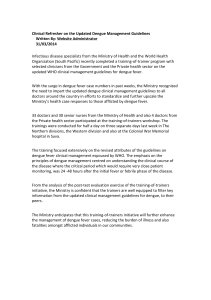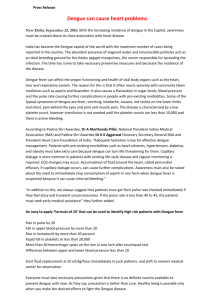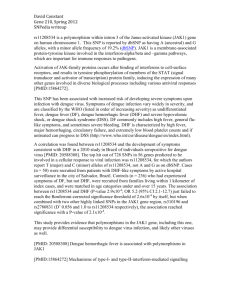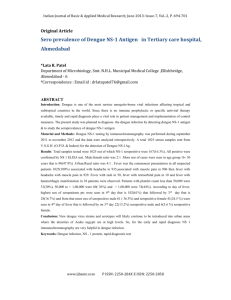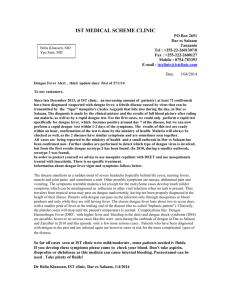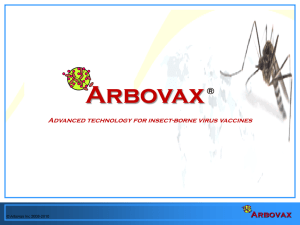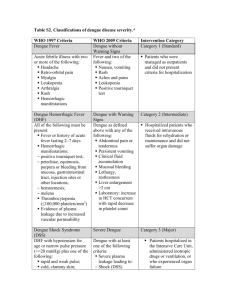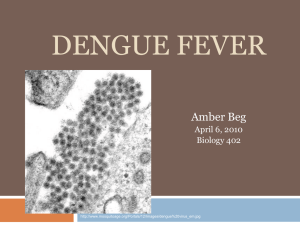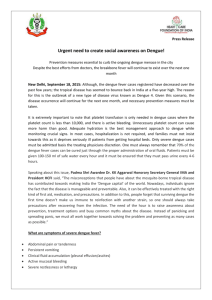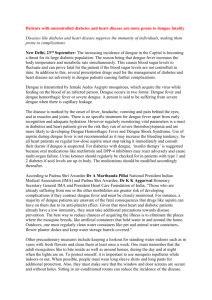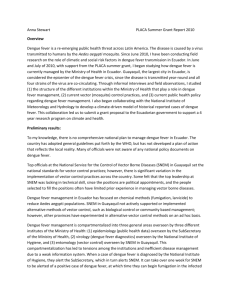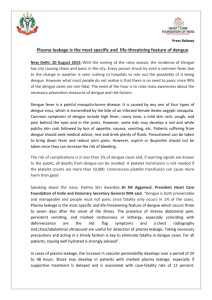Dengue Shock Syndrome
advertisement
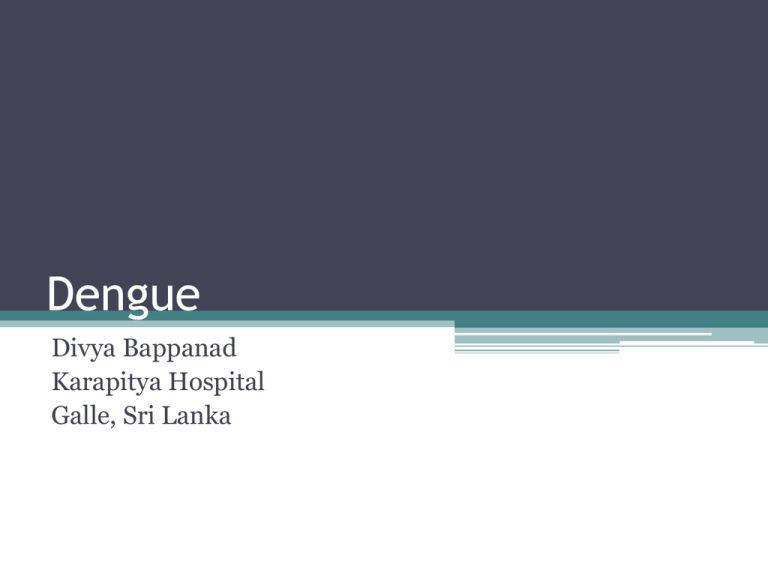
Dengue Divya Bappanad Karapitya Hospital Galle, Sri Lanka Initial Presentation • HPI: 18 yo Sri Lankan male in USOH until developed fever, myalgias and vomiting x 3 days. On basketball team and day prior to fever participated in game with no complaints. • PMH: none • Medications: none • Immunizations: up to date • SH: student, lives with mother in nearby community outside Galle, + electricity and running water, no siblings, no recent travel. Physical Exam • Vitals: T 40C BP 110/80 supine 90/70 standing HR 96 RR 16 SpO2 not available • Gen: Alert, Ill appearing • HEENT: PERRLA, EOMI, + conjunctival injection, OP clear, MM dry • Neck: No LAD • CV: RRR, no m/g/r • Lungs: CTAB, no w/r/r • Ab: +BS, soft, NT, ND, no HSM • Ext: No edema • Skin: No petechia Studies • WBC 5.2 86% N, 12% L and 1.2% M, Hgb 14 and Platelets 16,000 • Dengue IgM + and IgG + • CXR: clear Continued Clinical Course • Day 2 Coffee ground emesis ▫ Transfused FFP, plts and has transfusion rx • Day 3 Increased work of breathing ▫ Transferred to ICU and intubated ▫ Abx, plts and steroids • Day 4 Hypotension, decreased urine output with worsening hypoxia ▫ Started on pressors Progressive Deterioration • Day 6 Abdominal compartment syndrome ▫ Paracentesis with 1.5 L removed • Day 7 Worsening hypotension, decreased urine output and difficulty ventilating • Day 10 ▫ Withdrawal of ventilatory support Dengue Epidemiology • Incidence ▫ 2.5 billion people in over 100 endemic countries ▫ 50 million people infected annually with 500,000 cases of DHF and approx 20,000 deaths ▫ Wide spectrum of illness although most subclinical or asymptomatic • Dengue virus ▫ Flavivirus: Single Stranded RNA virus ▫ Serotypes: DEN-1 to DEN-4 ▫ DEN-2 and DEN-3 severe disease with secondary dengue infections Epidemiology • Vector ▫ Mosquito ▫ Primarily Aedes Aegypti Aedes albopictus, Aedes polynesiensis and other Aedes species also ▫ Most female Ae. aegypti appear to spend lifetime in or around the houses where they emerge as adults. ▫ Suggest people rather than mosquitoes, rapidly move the virus within and between communities Clinical Progression • Critical phase ▫ 3-7 days ▫ Temperature defervescence with possible increased capillary permeability and increasing hematocrit ▫ If no change in capillary permeability will improve and “non-severe dengue” ▫ If fail to defervesce and develop leakage concerning for development shock Clinical Progression • Recovery phase ▫ ▫ ▫ ▫ 2-3 days Reabsorption of extravascular fluid Bradycardia and ECG changes common Hemodynamics stabilize, auto diuresis begins and patient clinically improves Severe Dengue( Dengue Hemorrhagic Fever or Dengue Shock Syndrome) • Fever of 2–7 days plus : ▫ Evidence of plasma leakage, such as: high or rising hematocrit; pleural effusions or ascites; circulatory compromise or shock ▫ Significant bleeding. ▫ Altered level of consciousness (lethargy or restlessness, coma, convulsions). ▫ Severe gastrointestinal involvement (persistent vomiting, increasing or intense abdominal pain, jaundice). ▫ Severe organ impairment (acute liver failure, acute renal failure, encephalopathy or encephalitis, or other unusual manifestations, cardiomyopathy) or other unusual manifestations. Diagnosis • Clinical diagnosis ▫ Live and travel in endemic area and fever + 2 Anorexia and nausea Rash Myalgias/arthralgias Leukopenia Tourniquet test + Signs of severe dengue Serologic Diagnosis • Decreasing wbc ▫ 1st serologic abnormality • Dengue IgM and IgG ▫ tests viral specific antibodies ▫ 76% sensitive for primary infection and 88% for secondary infection ▫ 88%-99% specificity Treatment • Supportive • WHO management algorithm for fluid resuscitation • Transfusion • Oxygen • ICU monitering Prognosis • Dengue fever < 1% mortality • Dengue hemorrhagic fever approx 2.5% mortality ▫ Primarily children • Dengue shock up to 47% mortality Recurrent infection • Active infection protected from illness from different serotype for 2-3 months, but not long term • Infection by one serotype confirms lifelong immunity to that serotype • No immunization currently available Bibliography • Dengue: guidelines for diagnosis, treatment, prevention and control. Second edition. Geneva: World Health Organization. 2009. Accessed at http://whqlibdoc.who.int/publications/2009/9789241547871_eng. pdf • Singhi S, Kissoon N, Bansal A. Dengue and dengue hemorrhagic fever: management issues in an intensive care unit. J Pediatr (Rio J). 2007; 83(2 Suppl):S22-35.
